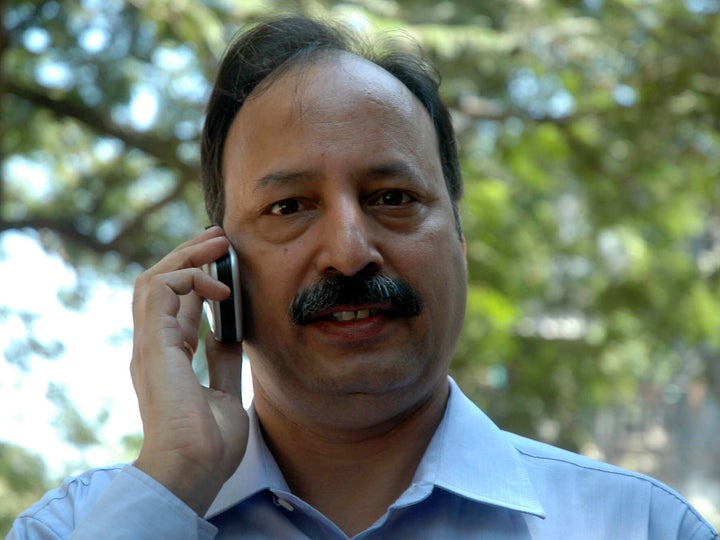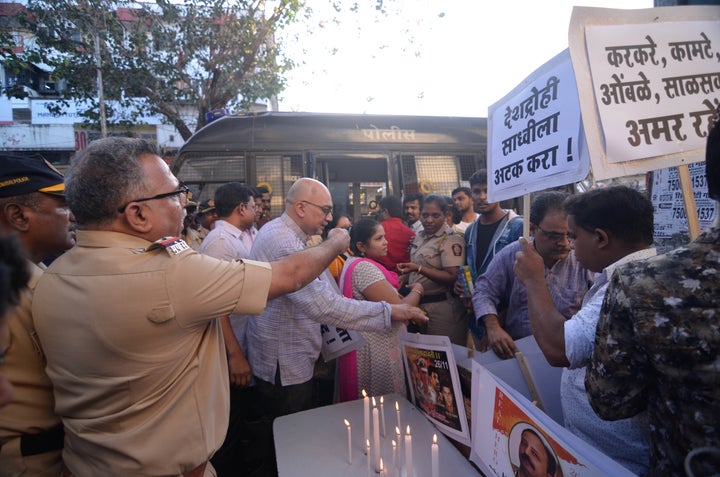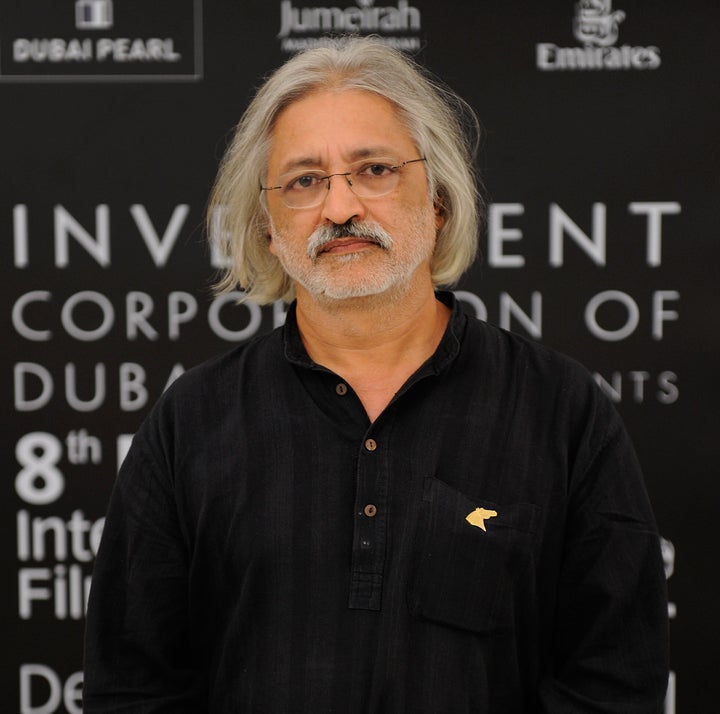
By the time ‘Terror and Stories of Terror’, the penultimate chapter in filmmaker Anand Patwardhan’s latest documentary, Reason, begins, viewers are already primed to look out for the leitmotif that signals yet another murder—a revving motorbike and gunshots piercing the silence of the night.
In Reason, which is divided into eight chapters, these sounds ominously precede the killings of rationalists, political activists and intellectuals such as Narendra Dabholkar, MM Kalburgi, Govind Pansare and Gauri Lankesh.
In this particular chapter, the person at the receiving end of the gunshots is Hemant Karkare, the former chief of the Maharashtra Anti-Terrorism Squad (ATS) who was killed while battling Pakistani Lashkar-e-Taiba terrorists during the 26/11 attacks in Mumbai.
Recently, almost 11 years after his death, Karkare made headlines again after Pragya Singh Thakur, the BJP’s Lok Sabha candidate from Bhopal who is also a terror suspect currently out on bail, accused him of torturing her in custody and shockingly claimed that it was her curse that led to the killing of the police officer—an Ashoka Chakra winner for bravery and a national hero since his death.
For the latest elections news and more, follow HuffPost India on Twitter, Facebook, and subscribe to our newsletter.
The controversy that erupted then, and which continues to fester, has put the spotlight back on Thakur; her bête noire Karkare; the contentious issue of Hindu terror and extremism in India; and the mystery and conspiracy theories that still surround the death of Karkare.
Made and released some months before Thakur’s candidature was announced, Patwardhan’s Reason, with its chapter on the Thakur-Karkare association, is a timely reminder of the nuts and bolts of the controversy. The four-hour Hindi subtitled version of the documentary, titled Vivek, is currently available on YouTube—the Karkare chapters are titled Vivek #14 and Vivek #15.
The film provides an unsettling account of how violent Hindu extremism and rightwing politics are trying to “systematically dismantle secular democracy” in India. In doing so, it is also well placed to offer additional insights into the violent Hindutva radicalism that has marked Narendra Modi’s years in power.

Life, death and controversies
The chapter picks up Karkare’s story as he heads investigations into September 2008’s Malegaon blast, which left six people dead and injured around 100. Pursuing the ownership trail of an LML Freedom motorbike used during the blast, the ATS arrested Thakur, among others.
Subsequently, the ATS’s investigations outlined the role played by shadowy fringe Hindu extremist groups such as Abhinav Bharat and Sanatan Sanstha in allegedly executing terror acts across India, mostly targeting Muslims. The role played by the RSS has also come into question.
Even as Reason recounts the incriminating evidence that emerged from laptops seized from the accused and charts the involvement of Hindutva terror cells as detailed in media reports, the Mumbai terror attacks of 26 November 2008 takes place concurrently. Karkare died in the wee hours of 27 November, allegedly to bullets fired by Pakistani terrorists Ajmal Kasab and Ismail Khan near Rang Bhavan.
“Hindu terror cells had been operative since 2003. It is one single brave officer, ATS Chief Hemant Karkare, and his team that had the guts to begin to expose the terror cells but he was cut down in mid-enquiry and the enquiry died with him,” Patwardhan said over email a few weeks after Reason was screened to a packed auditorium in Kolkata by a cultural-political organisation, People’s Film Collective, in March.
“The chapter 'Terror and Stories of Terror' is balanced between the last days of Karkare’s professional life and the raging debates that followed his death which have been reignited now by Thakur.”
Tellingly, Reason includes footage of IBN7 TV channel’s news broadcast on investigations into the Malegaon blast and the alleged criminal involvement of radical Hindutva elements like Swami Dayanand and Thakur getting rudely interrupted by ‘breaking news’ of the 26/11 attacks.
If the outcome of Karkare’s probe into the Malegaon blast—which topped a list of 17 blasts across India between 2003 and 2008 that killed scores of people and were purportedly executed by terror cells involving names such as Aseemanand, Thakur and Col. Shrikant Purohit—has been controversial, so has Karkare been in death. The chapter Terror and Stories of Terror is balanced between the last days of Karkare’s professional life and the raging debates that followed his death which have been reignited now by Thakur.
Questions and conspiracy theories
Since the night of Karkare’s killing, unanswered questions and conspiracy theories have cropped up in media reports—under whose instructions did Karkare head towards the site of his murder?; how did the bullet-proof jacket he was wearing go ‘missing’ from the hospital where he was taken?; was a sub-standard bullet-proof jacket provided to him?; why wasn’t an adequate backup of armed forces provided to a senior officer like Karkare as he went on the operation?
Doubts have also been raised over a portion of the testimony provided by the lone survivor of the attack, constable Arun Jadhav, deemed as “exaggerated” and “a lie” by special judge ML Tahaliyani. The denouncement of the Karkare-helmed ATS investigation into the Malegaon blast by the BJP top brass, including LK Advani, then Gujarat Chief Minister Modi, and more recently by former Lok Sabha speaker Sumitra Mahajan, have also featured prominently in media reports.
While Patwardhan ignores the controversy raised over Karkare’s poor-quality bullet-proof jacket which went missing from the hospital in Reason, he broadly hints at other contentious angles.
“The faulty bullet-proof jacket that went missing is suspicious but could be dismissed as ‘normal’ corruption, so I chose not to dwell on it. Much more damning is what I did include—the bullets that killed Karkare were neither fired from Kasab’s gun nor Ismail’s,” he said.
“This chapter of Vivek/Reason raised important questions about an incident where most people have entirely swallowed the official story. There are more than three voluminous books that ask unanswerable questions gleaned purely from the official transcripts of the case. If what is on record itself leads to such doubts, imagine what could emerge if a proper re-investigation took place,” Patwardhan added.
The narrative in ‘Terror and Stories of Terror’ is supported by the deposition of two important individuals. The chapter is interspersed by candid interviews with Rohini Salian, former special public prosecutor handling the Malegaon case who alleged she was asked to “go soft” on the accused by a National Investigation Agency (NIA) official one year after the BJP-led NDA government came to power in 2014.
Indeed, Reason plays back newspaper headlines screaming ‘Turnaround’ and ‘Shocking volte-face’ by the NIA since 2014. Significantly, the case against Hindu terror has seen witnesses turn hostile, statements of key witnesses in the Malegaon blast case go missing, a crucial confession by Aseemanand getting lost, many of the arrested having charges dropped against them, and bail for the prime accused, including Aseemanand, Col. Purohit and Pragya Thakur.
In tandem, there has been a concerted attempt to discredit Karkare’s investigations.
“Systematically I could make out that things weren’t moving in the right direction. I felt something is seriously wrong somewhere and why should I become a part of that game?” Salian explains in Reason as to why she went to the press in 2015 with her story.

Patwardhan also includes long sessions of interviews with SM Mushrif, Maharashtra’s former Inspector General of Police and a decorated officer who authored the book, Who Killed Karkare? The Real Face of Terrorism in India.
Reason uses available television footage of Karkare’s last documented moments in action on the night of 26 November 2008—he can be seen on the street wearing a helmet while another helmeted police officer points at a particular direction. Patwardhan’s voiceover here identifies the other officer giving directions to Karkare as KP Raghuvanshi, who was chief of Maharashtra ATS before Karkare succeeded him.
Raghuvanshi was reappointed ATS head immediately after Karkare’s death.
“Under Raghuvanshi, the ATS caught the wrong people in Malegaon. They caught nine Muslims,” goes the voiceover as news footage of Karkare’s last moments plays in the background. “And the night that Karkare died, the same night Raghuvanshi was reappointed as head of ATS,” it continues.
On crosschecking, we found Raghuvanshi was given additional charge of the ATS right after Karkare’s death and was formally appointed by the government on June 11, 2009. He was removed as ATS chief in less than a year after being pulled up by the centre.

Cycle of violence
In ‘Terror and Stories of Terror’, Patwardhan alludes to criminality, conspiracy and cover-up. Seen within the larger canvas of the painstakingly documented and researched four-hour film and Patwardhan’s bigger premise of Hindu extremist action and ambition in India, the chapter gains a persuasive aura of conviction. He introduces the context at the very beginning of Reason, citing the examples of the three religious organizations—the Muslim League, the Hindu Mahasabha and the RSS—getting founded in early 20th century in the wake of the establishment of the secular Congress party in 1885.
“All three sided with the British during the Quit India Movement and all three agreed that Hindus and Muslims can’t live together in one secular country,’ says the narrator of Reason.
“In independent India, the first initiative to destabilize secularism began with the assassination of Gandhiji in 1948. The killers called their act Asur Vadh (demon slaying),” the voiceover continues.
Such action, Patwardhan reckons, is work in progress. And the unprecedented instance in Indian secular democracy of a terror accused, Pragya Thakur, vying to enter Parliament while under trial, fits the pattern.
Patwardhan ends this chapter alluding to yet another murder that he connects to Karkare’s killing. This time, it is the turn of Communist Party of India leader Govind Pansare. About five years after the publication of Mushrif’s book on Karkare, Reason shows Pansare speaking in a public meeting about the conspiracy theories articulated in the book and declaring that he would publicise the contents of the book through 150 meetings in Maharashtra.
Some months later, on the morning of February 16, 2015, Pansare and his wife were shot at by motorcycle-borne assailants outside their home in Maharashtra’s Kolhapur while they were returning from a walk. He succumbed to the bullet injuries on February 20.
“Pansare was a mass leader who appealed both to the Left and to Dalit and other progressive groups, which must have put him on the rightists’ radar, but the actual final straw could well have been that he had begun to hold meetings about Karkare’s death,” said Patwardhan.
It’s time for the leitmotif to return in Reason—the deathly thunder of a motorbike and gunshots piercing the air.